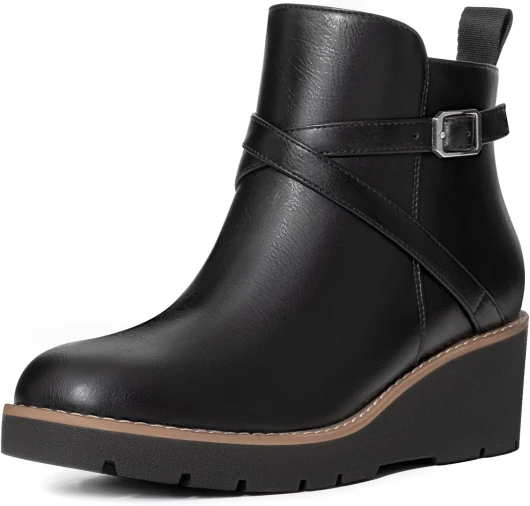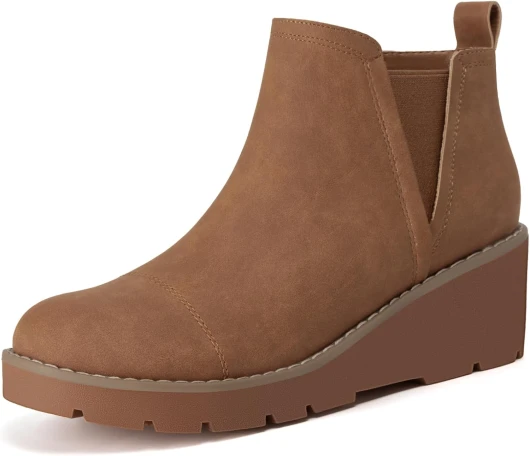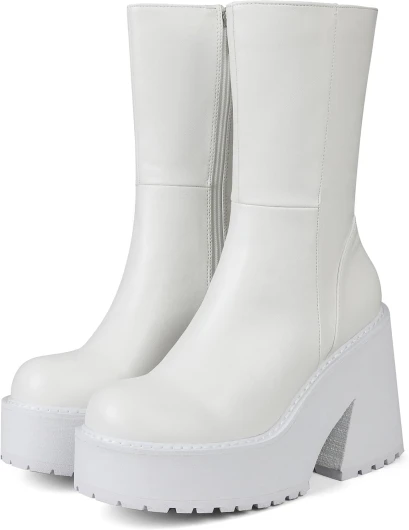
Understanding Wedge Heel Work Boots
Discovering the Nuances of Wedge Heel Work Boots
When it comes to finding the right footwear for outdoor adventures, wedge heel work boots present a compelling option that blends functionality and style. Unlike traditional work boots, wedge heel designs offer a unique take on rugged footwear that's aimed at providing enhanced stability and comfort during your outdoor pursuits. Wedge heel boots typically feature a sole that runs as a single piece from heel to toe, offering a smooth contour unlike the pronounced heel in other types of boots. This structure aims to distribute body weight more evenly across the foot, which adds to both comfort and stability during demanding hikes. For those seeking durability and protection, wedge heel work boots often come with options such as a steel toe or composite toe. These protective elements are essential, especially in challenging terrains where safety is paramount. Another functional aspect to note is the availability of waterproof varieties, which are critical in keeping your feet dry and comfortable across wet and muddy trails. Wedge heel work boots come in a variety of styles, from classic brown and black leather to moc toe designs. It's crucial to find a pair that fits well, considering factors like size and the specific demands of your outdoor activities. For instance, Georgia work boot options cater to professionals looking for a dependable boot with a wedge sole for daily use or adventurous hikes. Pricing varies greatly, with frequent sales providing opportunities to purchase high-quality boots at a reduced price. Considering the regular price and potential sale price is essential for budget-conscious outdoor enthusiasts. For a deeper dive into various options, including steel toe and waterproof work boots, and how they can meet your adventure needs, explore our detailed guide on steel toe boots for outdoor adventures.Advantages of Wedge Heel Work Boots for Hikers
Endurance and Durability: Why Wedge Heel Work Boots Stand Out
For hikers seeking versatility and comfort on rugged trails, wedge heel work boots offer numerous advantages. Unlike traditional hiking boots, wedge heel work boots come with a unique design that enhances stability and endurance during prolonged outdoor activities. The wedge sole provides a more even distribution of weight across the foot, which is essential for maintaining balance on uneven terrains.
One of the most striking benefits is the increased comfort due to the uniform sole structure. Unlike regular hiking boots, which may cause strain with segmented soles, wedge soles deliver a cushioned experience throughout the journey. In addition, these boots often feature a lightweight yet sturdy build that includes features like steel toe or composite toe, perfect for challenging environments.
Waterproof work functionalities can be found in many models, offering protection during wet conditions. Boots like Georgia wedge work boots often come with waterproof designs and safety toe options suitable for varying conditions and ensuring the utmost foot protection when traversing unpredictable paths.
Regarding customization, these boots can be found in different styles and sizes. Whether you prefer a moc toe or a sleek black or brown finish, there are choices to fit all preferences. A quick view at sales might also reveal a sale price, making these boots an economical choice without compromising quality.
For those concerned about protection, options like a steel toe waterproof boot offer additional safety for men involved in rigorous activities. Plus, the benefits of the electrical hazard protection feature are undeniable when operating in environments where electrical safety is a concern.
Finally, consider the versatility of Reebok safety boots as a noteworthy alternative for outdoor adventures. Their design often compares favorably to wedge heel work boots, ensuring you have multiple reliable options for your next hiking excursion.
Comparing Wedge Heel Work Boots to Traditional Hiking Boots
Traditional Hiking Boots vs. Wedge Heel Work Boots: A Quick Comparison
When it comes to choosing the right footwear for your outdoor adventures, understanding the differences between traditional hiking boots and wedge heel work boots is crucial. Both options offer unique benefits, but they cater to different needs and preferences.
Traditional hiking boots are designed with rugged terrains in mind. They often feature a high ankle support, a durable sole, and a waterproof exterior. These boots are typically favored by experienced hikers and mountaineers who tackle challenging trails. However, they can be heavier and less flexible, which might not be ideal for everyone.
On the other hand, wedge heel work boots offer a different set of advantages. These boots are known for their comfort and versatility, making them a popular choice for those who need a boot that can transition from work to trail. The wedge sole provides excellent cushioning, which can be beneficial for long hikes on flatter terrains. Additionally, many wedge heel work boots come with features like a steel toe or composite toe for added protection, making them suitable for environments where safety is a concern.
- Price: Wedge heel work boots can vary in price, often depending on features like waterproofing and safety toes. While they might be more affordable than some high-end hiking boots, it's essential to consider the specific needs of your adventure.
- Comfort: The wedge sole offers a softer feel, which can be more comfortable for extended wear. This is especially true for those who spend long hours on their feet.
- Durability: Both types of boots are built to last, but traditional hiking boots might offer more durability in rocky or uneven terrains due to their construction.
- Style: Wedge heel work boots often come in various styles, including moc toe and pull-on designs, available in colors like brown and black. This variety allows for more personal expression while maintaining functionality.
Ultimately, the choice between traditional hiking boots and wedge heel work boots depends on your specific needs and the nature of your outdoor activities. Whether you prioritize comfort, safety, or style, understanding these differences will help you make an informed decision.
Choosing the Right Wedge Heel Work Boots for Your Needs
Finding the Perfect Fit for Your Outdoor Needs
When it comes to selecting the right wedge heel work boots for your hiking adventures, there are several factors to consider. The right pair can make a significant difference in comfort and performance, so it's crucial to pay attention to details.
- Size and Fit: Ensure the boots fit snugly but comfortably. A proper fit is essential to prevent blisters and provide adequate support. Consider trying on boots with the socks you plan to wear during hikes.
- Material and Durability: Look for boots made from high-quality materials like waterproof leather or durable synthetics. This ensures longevity and protection against the elements.
- Toe Protection: Depending on your hiking environment, you might need steel toe or composite toe options for added safety. These features are particularly useful in rocky terrains or when carrying heavy loads.
- Sole and Traction: A wedge sole can offer excellent stability and grip on various surfaces. Make sure the sole is designed to handle the specific terrains you plan to explore.
- Price and Budget: While it's tempting to go for the cheapest option, investing in a quality pair of boots can save you money in the long run. Look for sales or discounts to get the best value for your budget.
- Style and Color: Although not as crucial as functionality, choosing a style and color you like, such as classic brown or black, can enhance your overall hiking experience.
By considering these factors, you can find a pair of wedge heel work boots that not only meet your hiking needs but also provide comfort and durability for many adventures to come.
Maintenance Tips for Wedge Heel Work Boots
Caring for Your Investment: Key Tips for Wedge Heel Work Boots
Keeping your wedge heel work boots in excellent condition ensures they remain reliable companions on all your outdoor adventures. By following these maintenance tips, you’ll protect your boots from wear and tear, maximizing their lifespan and performance.- Regular Cleaning: Consistently removing dirt and debris from the boot’s surface is essential. Use a soft brush or cloth to clean both the wedge and sole, focusing on intricate areas like the moc toe. This routine maintenance can prevent buildup that deteriorates materials over time, particularly hazards like electrical hazard-rated boots.
- Waterproofing: Even if your boots are initially waterproof, periodic reapplication of a waterproofing spray is recommended. This is crucial for maintaining the integrity of the waterproof work boots, especially when consistently exposed to wet conditions.
- Condition the Leather: Your investment in quality boots like Georgia or steel toe varieties means more robust leather, which benefits from occasional conditioning. Applying a leather conditioner helps retain the softness and flexibility of the material, reducing the risk of cracking. Make sure to adhere to the manufacturer's guidelines for the best results.
- Inspect the Soles: The wedge sole and other sole types are fundamental to your boot’s performance and your safety. Regularly inspect for signs of wear, such as thinning or splitting. These can indicate the need for a resole before it becomes a safety issue.
- Proper Storage: When not in use, store your boots in a dry, cool place away from direct sunlight. Stuffing the boots with newspaper or using boot trees can help maintain their shape and absorb any residual moisture. This is especially beneficial for steel toe or composite toe variants to ensure they remain fit for use.
- Monitor for Repairs: Keep an eye on areas like the steel toe and stitches. Quick repairs to loose stitches or minor damages can prevent more costly issues later. Whether black, brown or other colors, any visual damage can affect the overall boot’s appeal and utility.

















